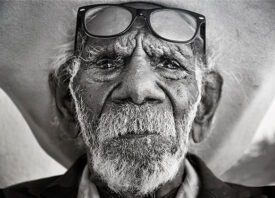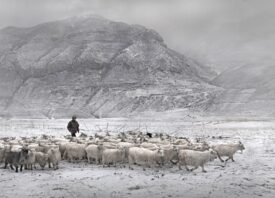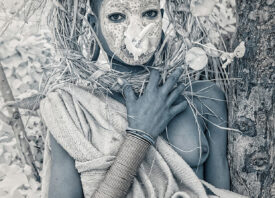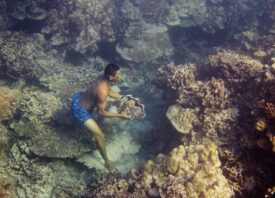Search this site
Documentary photographer Alegra Ally reflects on cultural adaptation, indigenous motherhood and ancient traditions

Alegra Ally is an award-winning ethnographer and documentary photographer who has dedicated her life to using film, photography and writing to document the traditional practices and beliefs of indigenous women as part of The Wild Born Project.
From living in caves with the remote Meakambut tribe of Papua New Guinea, to witnessing the birthing rituals of the isolated ovaHimba people of Namibia, Ally’s work has taken her across the globe – and a long way from her native Israel.
Ally’s latest project took her to the Yamal Peninsula in Northwest Siberia to live with a family of nomadic Nenets as they follow ancient migration paths, herding reindeer for thousands of kilometres across the Arctic.

In her new book, New Path – A Window on Nenets Life, Ally tells the story of Lena, the pregnant Nenets woman that Ally lived with during her time in the Siberian Arctic.
We spoke to Ally to learn more about her experience with the Nenets, what motivates her life’s work and how working with indigenous mothers has influenced her own ideas of motherhood.
What motivated you to study and document the Nenets’ way of life?
“Women at the end of the land expedition is one among many I have undertaken as part of a larger initiative called The Wild Born Project. Since 2011, I have used ethical photography and ethnography to document the traditional practices and beliefs underlying the major life events of indigenous women. From early rites of passage, through to pregnancy, birth and postpartum rituals, this world of women’s experience and wisdom has been the inspiration and foundation for my work as an anthropologist and documentary photographer.
“It is my intention, through these expeditions, to create awareness and appreciation for traditional knowledge and practices, and to contribute to the revitalization of traditional ways of life for future generations.
“With each expedition, my aim has been to meet with a woman who is pregnant, and who will give birth during my stay. Finding Lena, a nomadic Nenets woman who was close to giving birth, was a challenge. Until I arrived, I did not know exactly how far along she would be in her pregnancy. My journey with Lena and her family took many unexpected turns.”

“Lena did give birth while I was with the family during an extremely challenging season where winter migration did not go as planned. The birth saga came to be emblematic of the Nenets’ struggle to keep their cultural heritage and highly adapted way of life intact in this modern age.
“Through offering a rare glimpse into a way of life that exists on a rapidly changing landscape, I hope to provide an understanding of the inherent changes that both enrich and threaten the Nenets collective identity as nomadic reindeer herders.”
During your 6-week journey you faced freezing temperatures, extreme isolation, relentless travel and a completely different diet. How did you balance studying the Nenets while dealing with these challenges?
“In the framework of an ethnographer, my goal is to immerse myself in the ways of life of the people I visit. Yet, nothing could quite prepare me to the harsh Arctic conditions which added even bigger admiration to the resilience of the Nenets. It is truly a place where one must ‘expect the unexpected’ and is one of my biggest lessons of living in the Tundra amongst the Nenets.
“I started working in remote locations two decades ago and each time I arrive in a new place I have to adapt to a new environment as well learn a new set of local beliefs and rules. I’ve learned to balance myself with time which is based on the experience of knowing that I need to allocate time for adjustment, getting to know the culture, the people and the challenges the environment brings.

“My main challenges are both physical and physiological. One big challenge which people often are not aware of is loneliness. It is a complicated issue, but learning to embrace it and not resist allows an immense personal growth.
“I can say that I mostly enjoy the challenge and appreciate it. It’s partially what gives the experience its intensity and its depth of learning and growth. Easier said than done while on the field.”
While in Yamal you experienced the full force of winter in the Russian Artic, battling through temperatures of -50°C – a far cry from your native Israel. How did you manage to keep warm?
“I have long waited to experience the Arctic winter. I purposefully choose to arrive during winter because I wanted to witness and learn about the Nenets remarkable adaptation to their environment and how they survive the daily life.
“What seem to be basic daily chores were almost impossible for me to perform when adding the howling winds and snow.
“I experienced frost bite and no matter how well equipped I was with my arctic gear, the cold penetrated to my core. This was especially apparent while travelling in an open wooden sledge pulled by reindeer.
“Towards mid winter I gave up my own clothing and was given a traditional Nenets costume as well as boots and mittens which remarkably gave me full protection from the elements. That was another step in understanding the adaptations the Nenets had to achieve in order to survive (and thrive) in some of the most hostile environments in the world.”
What photography equipment do you normally take along on these arduous anthropological trips?
“The gear I take greatly depends on the climate zone and remoteness of the location. Beyond the specialised clothing, I have to place a big emphasis on photography gear selection. As most of my destinations are very remote, I usually bring a solar panel and charger for my gear.

“I always bring two chargers, many batteries (batteries do not last long in very cold conditions and I have to store them inside my clothing against my skin to keep them warm), a tripod, two camera bodies and a few lenses.
“In Siberia, as there is no sun we relied on generators. On one occasion, the generator broke and we had to travel for two hours in a snowmobile to a trading station to charge a few batteries. I sometime bring a GoPro for unobtrusive filming in tight places where I can simply position the camera and go. In warmer climates I usually sleep in an expedition hammock or in a tent.
“I sometimes bring food supplements to provide some extra nutrition as I cannot eat all food consumed by the communities. I also bring water purifying tablets if there is no clean water. For the Siberia trip, I was fortunate to be sponsored by a gear company in Australia (Mountain Designs), which outfitted me with their arctic range.”
Your work has highlighted the many threats upon the Nenets’ lifestyle – from resource extraction developments to globalisation and climate change. What messages do you hope people take from your work?
“I believe it is very important to understand the reality that many indigenous societies are facing including the Nenets, and that change is inevitable, and that change is not always a threat to culture.
“The Nenets did not stop being Nenets when they began to use snowmobile as transportation as a replacement to their ancient wooden sledges, they did not abandon their nomadic lifestyle following their ancestors as they lived for thousand of years when they introduced motorised snowmobiles. But it is our myopic approach to ethnocentrism and how it defines our actions as a means of power and domination over other societies.
“These are societies that are overwhelmed by powerful external forces beyond their capacity to adapt to, and the results are that in this way they are being forced out of existence.

“I would also argue that cultural diversity is important and the fact that humans have adapted to live in any corner of our planet no matter how remote or hostile is a sign for hope and inspiration. It’s not about what is the right way to live or which society is better progressed. It’s not who is ‘modern’ and who is ‘left behind’.
“There are many ways of being and existing in this world. Cultures are dynamic, vivid, encapsulating our history, dreams, hopes, stories, creativity, our spirit, we all have a unique way of contributing to the liveliness of the world, we all add a different spectrum of colour. They are all equal contributors to what it means to be human.
“We could all learn by example from indigenous people as well as the Nenets of how humans can co-exist with nature, adapt and live consciously and sustainably without over exploiting it and see how this approach can help us thrive and live healthier and safer/protected life.”
Having recently become a mother yourself, how did your experience of indigenous motherhood through The Wild Born Project influence your own ideas of being a mother?
“Working on The Wild Born Project has enabled me to pass the most important rite of passage in my life, that is becoming a mother. I became a mother partially thanks to the project as it helped me access a tremendous and powerful amount of knowledge and experiences that catalyzed my desire to have a baby.”

“The first birth I was honoured to witness amongst the Himba women of Namibia was a life-changing event for me. Observing and taking a part of a women circle in a small mud hut, watching how birth with all its challenges, and risks can also be a positive and empowering experience.
“How birth can be natural and safe, learning the importance of a women circle, what it means to be nurtured by other women and a midwife, how it changes the whole outcome of the birth and influences the health and wellbeing of both mother, baby and the whole community.”
“The biggest ‘aha!’ moment of my life was revealing itself right in front of my eyes- as women, we give life, we birth, this is the most powerful “super power” given to us as woman. It must be an act of love, not fear, in a loving environment not a hostile environment, because the way we birth can either build or take apart our communities.
“I’ve learned that the way we birth has so much significance – it can actually change the face of our societies.”
How has your ethnographic approach changed since your first solo expedition as a 17-year-old to Papua New Guinea?
“When I started travelling, I was not an ethnographer – I was curious and wanted to understand how tribal people live. With time, I began to view it from a more academic perspective. Nothing can replace the years of experience in working in the field with indigenous peoples.

“This kind of knowledge is not being taught in any university. You have to earn it. It’s a constant evolvement, expansion ,and ripening. I first had to really understand the intensity and enormity of the project, then of course learn how to better communicate it to the world.
“Finally, I had to learn to be of better service to the people and communities I work with. What has stayed with me since that first journey though, is my passion, faith and appreciation.”
What advice would you give to someone who is interested in doing what you do?
“Don’t be taken back by how big the project is or how much there is to do –take the first step and know that you can grow into it.
“Treat your project as its own entity. Like in every relationship, don’t try to over control or manipulate it in any way. The faster you learn to release, to set it free in a sense, free from your own limitations, fears, definitions, you are truly bringing it to life and giving it its best chance of fulfilment.
“Once you allow it authenticity, then the magic happens, it begins to generate energy of its own.”
Alegra Ally’s book, New Path – A Window on Nenets life, will be published in July in Europe and August across the United States by Schilt Publishing. You can preorder the book here and learn more about Ally on her website.




